Business Plan: Goldy Indoor Sports Facility in New Zealand Market
VerifiedAdded on 2023/06/06
|55
|13228
|246
AI Summary
This business plan details the launch of Goldy Indoor Sports, an indoor sports facility in New Zealand, focusing initially on cricket, football, and netball in the Spreydon area of Christchurch. The plan includes an industry review highlighting the growing sports market in New Zealand and the lack of indoor sports spaces. It identifies market opportunities, customer needs, and competition, including Howzat Indoor Sports and Pioneer Leisure Centre. The plan explores product and service strategies, analyzes market feasibility using innovation models and Porter's Five Forces, and assesses organizational and financial feasibility through SWOT, PESTEL, and financial modeling. It also addresses growth and sustainability potential, including scalability, market penetration, and funding strategies. The venture aims to become the largest indoor sports facility chain in New Zealand, targeting young sports enthusiasts aged 13-20 and expanding to smaller towns and potentially Australia.

Running head: BUSINESS PLAN FOR AN INDOOR SPORTS BUSINESS
Business Plan for an Indoor Sports Business
Name of the Student
Name of the University
Author note
Business Plan for an Indoor Sports Business
Name of the Student
Name of the University
Author note
Paraphrase This Document
Need a fresh take? Get an instant paraphrase of this document with our AI Paraphraser
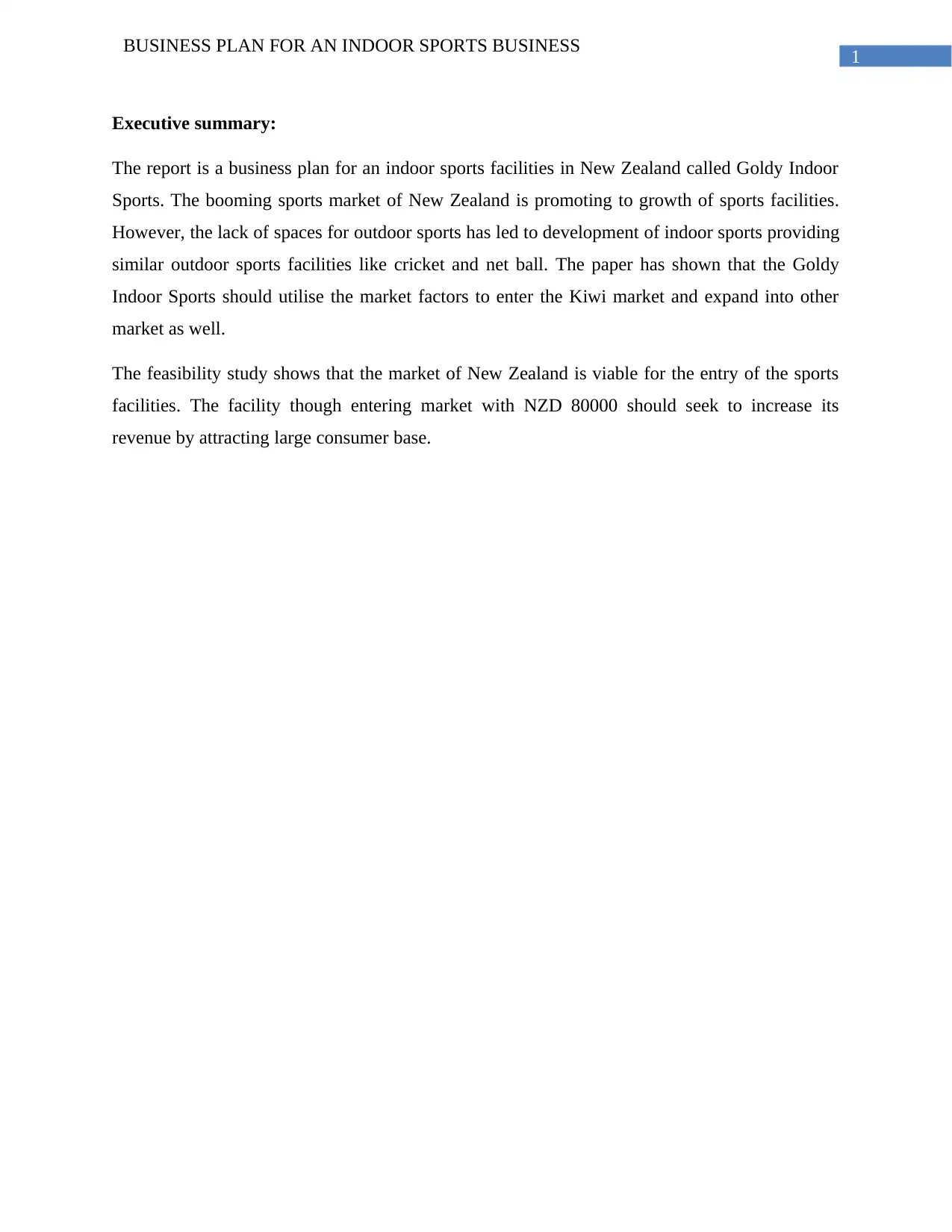
1
BUSINESS PLAN FOR AN INDOOR SPORTS BUSINESS
Executive summary:
The report is a business plan for an indoor sports facilities in New Zealand called Goldy Indoor
Sports. The booming sports market of New Zealand is promoting to growth of sports facilities.
However, the lack of spaces for outdoor sports has led to development of indoor sports providing
similar outdoor sports facilities like cricket and net ball. The paper has shown that the Goldy
Indoor Sports should utilise the market factors to enter the Kiwi market and expand into other
market as well.
The feasibility study shows that the market of New Zealand is viable for the entry of the sports
facilities. The facility though entering market with NZD 80000 should seek to increase its
revenue by attracting large consumer base.
BUSINESS PLAN FOR AN INDOOR SPORTS BUSINESS
Executive summary:
The report is a business plan for an indoor sports facilities in New Zealand called Goldy Indoor
Sports. The booming sports market of New Zealand is promoting to growth of sports facilities.
However, the lack of spaces for outdoor sports has led to development of indoor sports providing
similar outdoor sports facilities like cricket and net ball. The paper has shown that the Goldy
Indoor Sports should utilise the market factors to enter the Kiwi market and expand into other
market as well.
The feasibility study shows that the market of New Zealand is viable for the entry of the sports
facilities. The facility though entering market with NZD 80000 should seek to increase its
revenue by attracting large consumer base.
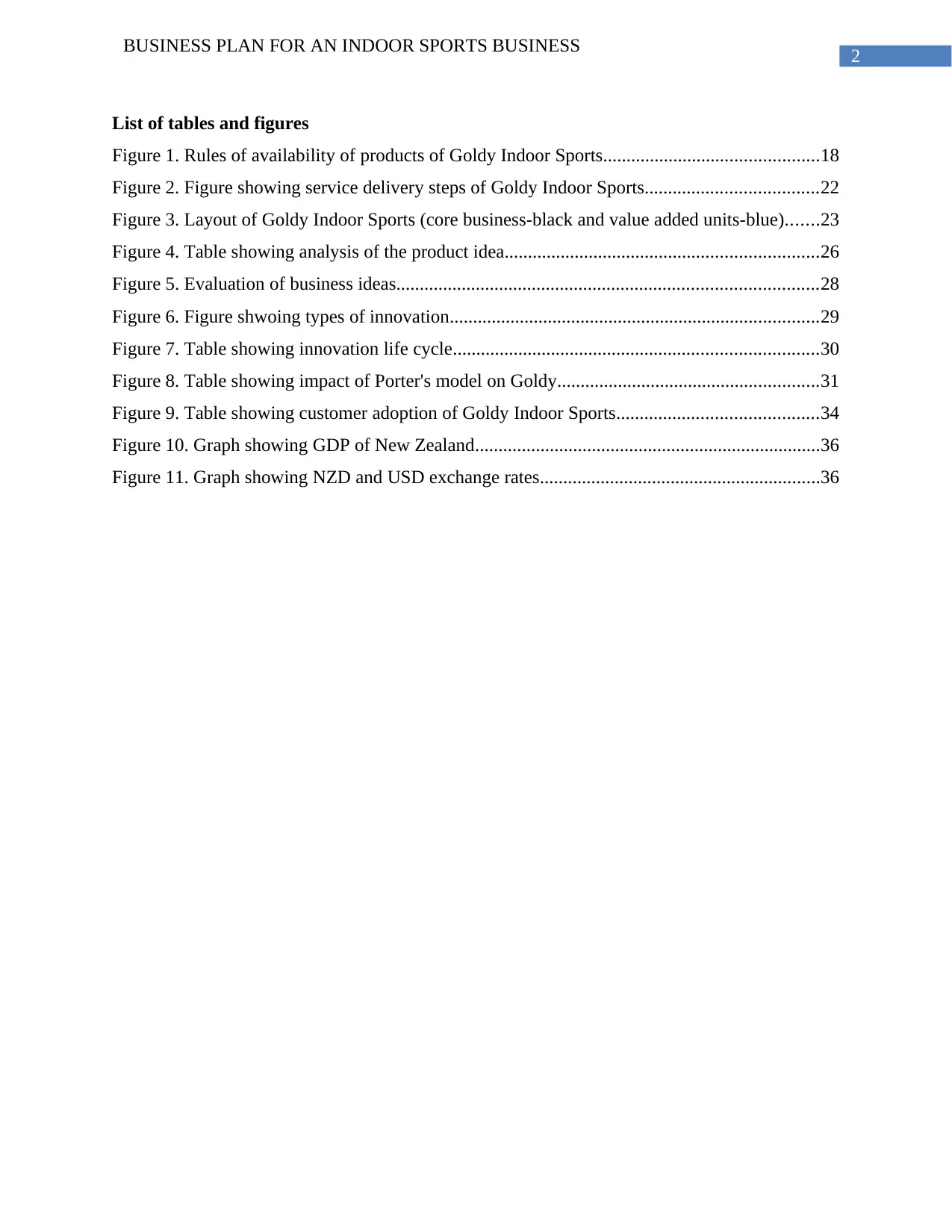
2
BUSINESS PLAN FOR AN INDOOR SPORTS BUSINESS
List of tables and figures
Figure 1. Rules of availability of products of Goldy Indoor Sports..............................................18
Figure 2. Figure showing service delivery steps of Goldy Indoor Sports.....................................22
Figure 3. Layout of Goldy Indoor Sports (core business-black and value added units-blue).......23
Figure 4. Table showing analysis of the product idea...................................................................26
Figure 5. Evaluation of business ideas..........................................................................................28
Figure 6. Figure shwoing types of innovation...............................................................................29
Figure 7. Table showing innovation life cycle..............................................................................30
Figure 8. Table showing impact of Porter's model on Goldy........................................................31
Figure 9. Table showing customer adoption of Goldy Indoor Sports...........................................34
Figure 10. Graph showing GDP of New Zealand..........................................................................36
Figure 11. Graph showing NZD and USD exchange rates............................................................36
BUSINESS PLAN FOR AN INDOOR SPORTS BUSINESS
List of tables and figures
Figure 1. Rules of availability of products of Goldy Indoor Sports..............................................18
Figure 2. Figure showing service delivery steps of Goldy Indoor Sports.....................................22
Figure 3. Layout of Goldy Indoor Sports (core business-black and value added units-blue).......23
Figure 4. Table showing analysis of the product idea...................................................................26
Figure 5. Evaluation of business ideas..........................................................................................28
Figure 6. Figure shwoing types of innovation...............................................................................29
Figure 7. Table showing innovation life cycle..............................................................................30
Figure 8. Table showing impact of Porter's model on Goldy........................................................31
Figure 9. Table showing customer adoption of Goldy Indoor Sports...........................................34
Figure 10. Graph showing GDP of New Zealand..........................................................................36
Figure 11. Graph showing NZD and USD exchange rates............................................................36
⊘ This is a preview!⊘
Do you want full access?
Subscribe today to unlock all pages.

Trusted by 1+ million students worldwide
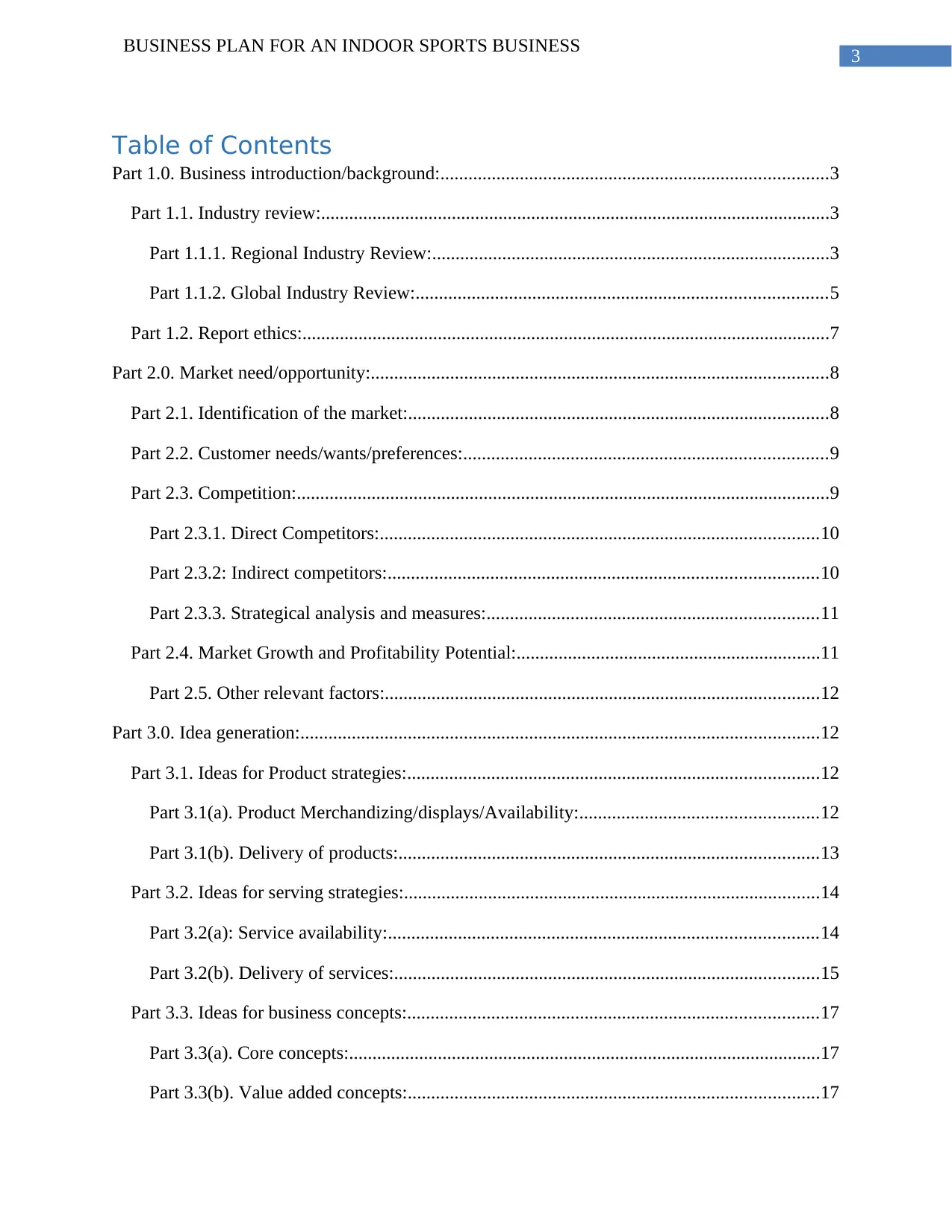
3
BUSINESS PLAN FOR AN INDOOR SPORTS BUSINESS
Table of Contents
Part 1.0. Business introduction/background:...................................................................................3
Part 1.1. Industry review:.............................................................................................................3
Part 1.1.1. Regional Industry Review:.....................................................................................3
Part 1.1.2. Global Industry Review:........................................................................................5
Part 1.2. Report ethics:.................................................................................................................7
Part 2.0. Market need/opportunity:..................................................................................................8
Part 2.1. Identification of the market:..........................................................................................8
Part 2.2. Customer needs/wants/preferences:..............................................................................9
Part 2.3. Competition:..................................................................................................................9
Part 2.3.1. Direct Competitors:..............................................................................................10
Part 2.3.2: Indirect competitors:............................................................................................10
Part 2.3.3. Strategical analysis and measures:.......................................................................11
Part 2.4. Market Growth and Profitability Potential:.................................................................11
Part 2.5. Other relevant factors:.............................................................................................12
Part 3.0. Idea generation:...............................................................................................................12
Part 3.1. Ideas for Product strategies:........................................................................................12
Part 3.1(a). Product Merchandizing/displays/Availability:...................................................12
Part 3.1(b). Delivery of products:..........................................................................................13
Part 3.2. Ideas for serving strategies:.........................................................................................14
Part 3.2(a): Service availability:............................................................................................14
Part 3.2(b). Delivery of services:...........................................................................................15
Part 3.3. Ideas for business concepts:........................................................................................17
Part 3.3(a). Core concepts:.....................................................................................................17
Part 3.3(b). Value added concepts:........................................................................................17
BUSINESS PLAN FOR AN INDOOR SPORTS BUSINESS
Table of Contents
Part 1.0. Business introduction/background:...................................................................................3
Part 1.1. Industry review:.............................................................................................................3
Part 1.1.1. Regional Industry Review:.....................................................................................3
Part 1.1.2. Global Industry Review:........................................................................................5
Part 1.2. Report ethics:.................................................................................................................7
Part 2.0. Market need/opportunity:..................................................................................................8
Part 2.1. Identification of the market:..........................................................................................8
Part 2.2. Customer needs/wants/preferences:..............................................................................9
Part 2.3. Competition:..................................................................................................................9
Part 2.3.1. Direct Competitors:..............................................................................................10
Part 2.3.2: Indirect competitors:............................................................................................10
Part 2.3.3. Strategical analysis and measures:.......................................................................11
Part 2.4. Market Growth and Profitability Potential:.................................................................11
Part 2.5. Other relevant factors:.............................................................................................12
Part 3.0. Idea generation:...............................................................................................................12
Part 3.1. Ideas for Product strategies:........................................................................................12
Part 3.1(a). Product Merchandizing/displays/Availability:...................................................12
Part 3.1(b). Delivery of products:..........................................................................................13
Part 3.2. Ideas for serving strategies:.........................................................................................14
Part 3.2(a): Service availability:............................................................................................14
Part 3.2(b). Delivery of services:...........................................................................................15
Part 3.3. Ideas for business concepts:........................................................................................17
Part 3.3(a). Core concepts:.....................................................................................................17
Part 3.3(b). Value added concepts:........................................................................................17
Paraphrase This Document
Need a fresh take? Get an instant paraphrase of this document with our AI Paraphraser
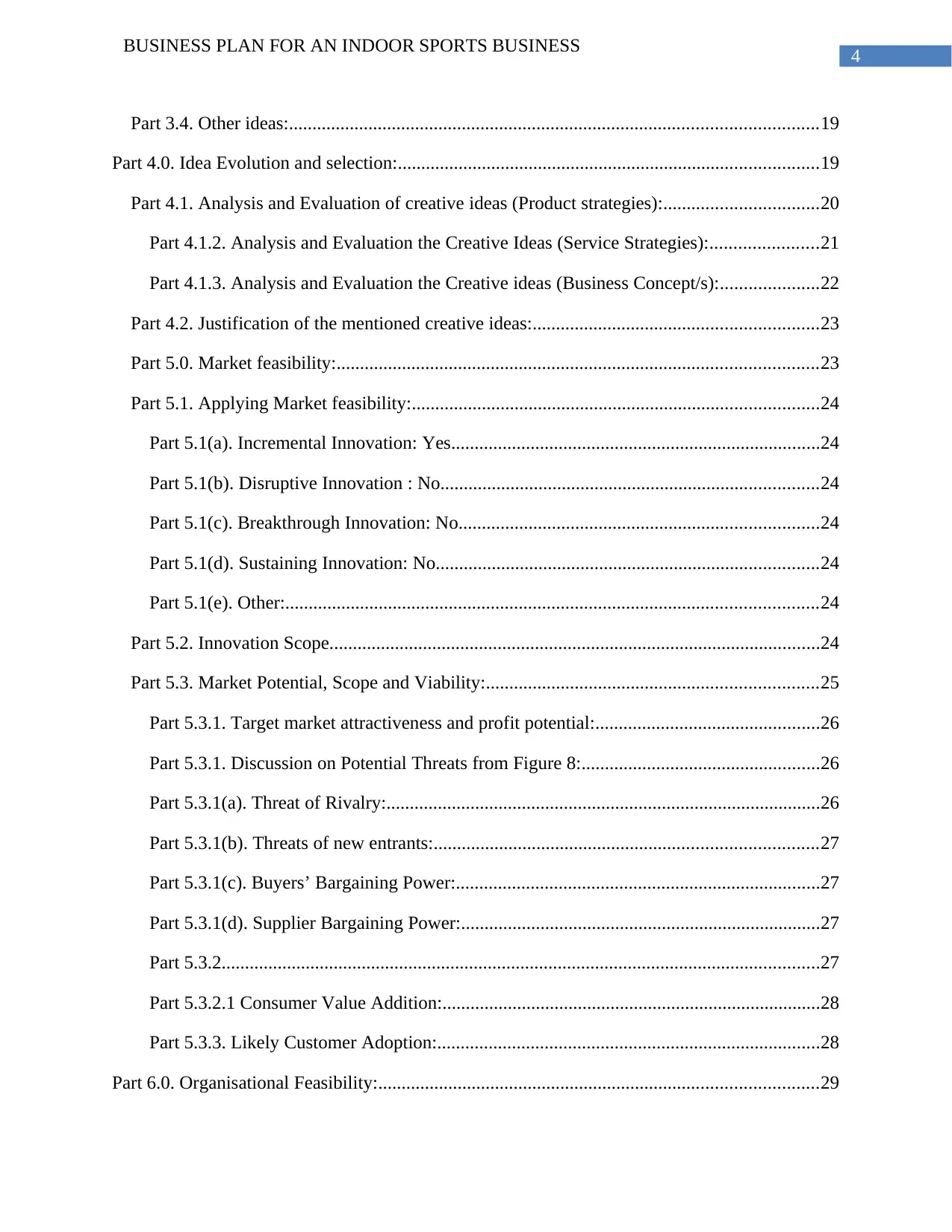
4
BUSINESS PLAN FOR AN INDOOR SPORTS BUSINESS
Part 3.4. Other ideas:.................................................................................................................19
Part 4.0. Idea Evolution and selection:..........................................................................................19
Part 4.1. Analysis and Evaluation of creative ideas (Product strategies):.................................20
Part 4.1.2. Analysis and Evaluation the Creative Ideas (Service Strategies):.......................21
Part 4.1.3. Analysis and Evaluation the Creative ideas (Business Concept/s):.....................22
Part 4.2. Justification of the mentioned creative ideas:.............................................................23
Part 5.0. Market feasibility:.......................................................................................................23
Part 5.1. Applying Market feasibility:.......................................................................................24
Part 5.1(a). Incremental Innovation: Yes...............................................................................24
Part 5.1(b). Disruptive Innovation : No.................................................................................24
Part 5.1(c). Breakthrough Innovation: No.............................................................................24
Part 5.1(d). Sustaining Innovation: No..................................................................................24
Part 5.1(e). Other:..................................................................................................................24
Part 5.2. Innovation Scope.........................................................................................................24
Part 5.3. Market Potential, Scope and Viability:.......................................................................25
Part 5.3.1. Target market attractiveness and profit potential:................................................26
Part 5.3.1. Discussion on Potential Threats from Figure 8:...................................................26
Part 5.3.1(a). Threat of Rivalry:.............................................................................................26
Part 5.3.1(b). Threats of new entrants:..................................................................................27
Part 5.3.1(c). Buyers’ Bargaining Power:..............................................................................27
Part 5.3.1(d). Supplier Bargaining Power:.............................................................................27
Part 5.3.2................................................................................................................................27
Part 5.3.2.1 Consumer Value Addition:.................................................................................28
Part 5.3.3. Likely Customer Adoption:..................................................................................28
Part 6.0. Organisational Feasibility:..............................................................................................29
BUSINESS PLAN FOR AN INDOOR SPORTS BUSINESS
Part 3.4. Other ideas:.................................................................................................................19
Part 4.0. Idea Evolution and selection:..........................................................................................19
Part 4.1. Analysis and Evaluation of creative ideas (Product strategies):.................................20
Part 4.1.2. Analysis and Evaluation the Creative Ideas (Service Strategies):.......................21
Part 4.1.3. Analysis and Evaluation the Creative ideas (Business Concept/s):.....................22
Part 4.2. Justification of the mentioned creative ideas:.............................................................23
Part 5.0. Market feasibility:.......................................................................................................23
Part 5.1. Applying Market feasibility:.......................................................................................24
Part 5.1(a). Incremental Innovation: Yes...............................................................................24
Part 5.1(b). Disruptive Innovation : No.................................................................................24
Part 5.1(c). Breakthrough Innovation: No.............................................................................24
Part 5.1(d). Sustaining Innovation: No..................................................................................24
Part 5.1(e). Other:..................................................................................................................24
Part 5.2. Innovation Scope.........................................................................................................24
Part 5.3. Market Potential, Scope and Viability:.......................................................................25
Part 5.3.1. Target market attractiveness and profit potential:................................................26
Part 5.3.1. Discussion on Potential Threats from Figure 8:...................................................26
Part 5.3.1(a). Threat of Rivalry:.............................................................................................26
Part 5.3.1(b). Threats of new entrants:..................................................................................27
Part 5.3.1(c). Buyers’ Bargaining Power:..............................................................................27
Part 5.3.1(d). Supplier Bargaining Power:.............................................................................27
Part 5.3.2................................................................................................................................27
Part 5.3.2.1 Consumer Value Addition:.................................................................................28
Part 5.3.3. Likely Customer Adoption:..................................................................................28
Part 6.0. Organisational Feasibility:..............................................................................................29
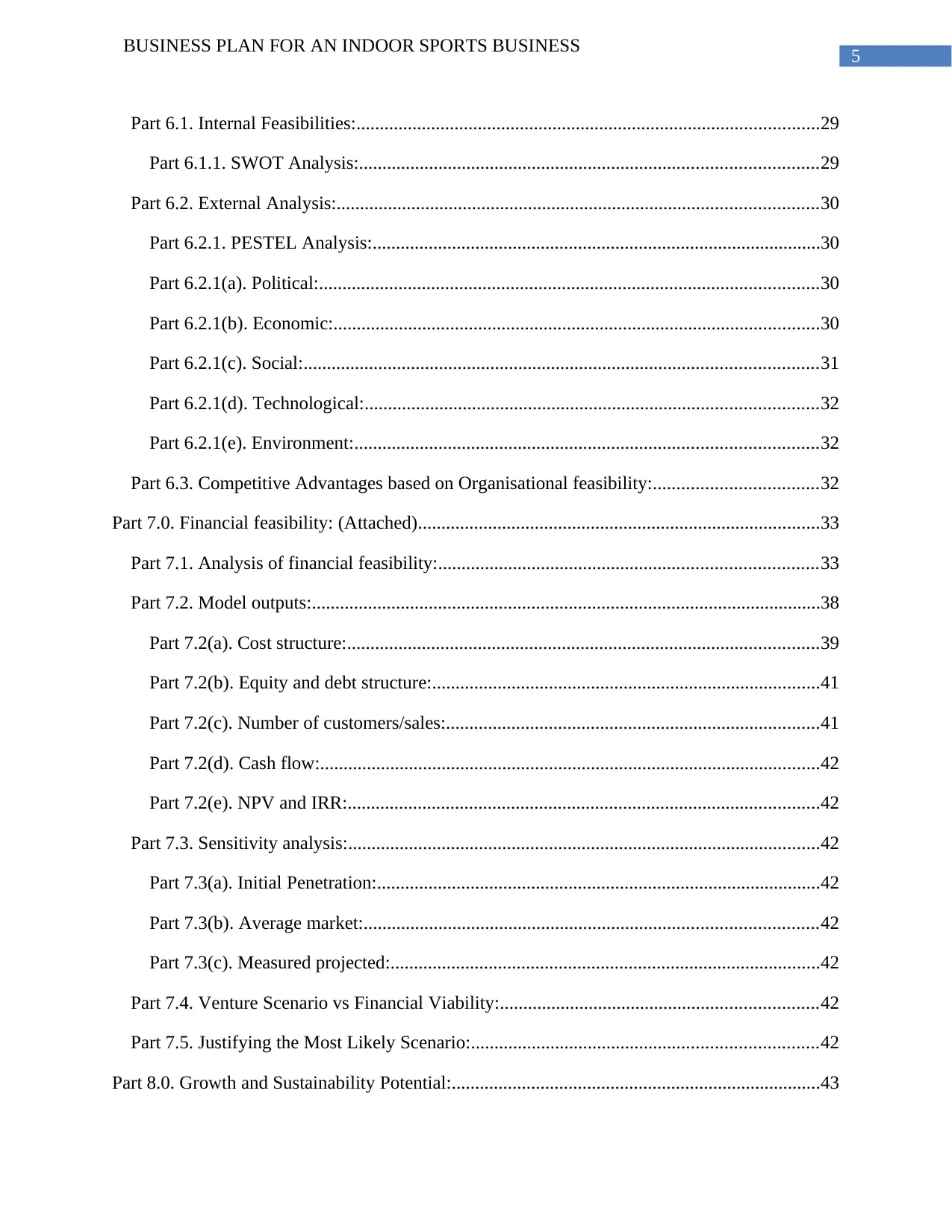
5
BUSINESS PLAN FOR AN INDOOR SPORTS BUSINESS
Part 6.1. Internal Feasibilities:...................................................................................................29
Part 6.1.1. SWOT Analysis:..................................................................................................29
Part 6.2. External Analysis:.......................................................................................................30
Part 6.2.1. PESTEL Analysis:................................................................................................30
Part 6.2.1(a). Political:...........................................................................................................30
Part 6.2.1(b). Economic:........................................................................................................30
Part 6.2.1(c). Social:..............................................................................................................31
Part 6.2.1(d). Technological:.................................................................................................32
Part 6.2.1(e). Environment:...................................................................................................32
Part 6.3. Competitive Advantages based on Organisational feasibility:...................................32
Part 7.0. Financial feasibility: (Attached)......................................................................................33
Part 7.1. Analysis of financial feasibility:.................................................................................33
Part 7.2. Model outputs:.............................................................................................................38
Part 7.2(a). Cost structure:.....................................................................................................39
Part 7.2(b). Equity and debt structure:...................................................................................41
Part 7.2(c). Number of customers/sales:................................................................................41
Part 7.2(d). Cash flow:...........................................................................................................42
Part 7.2(e). NPV and IRR:.....................................................................................................42
Part 7.3. Sensitivity analysis:.....................................................................................................42
Part 7.3(a). Initial Penetration:...............................................................................................42
Part 7.3(b). Average market:.................................................................................................42
Part 7.3(c). Measured projected:............................................................................................42
Part 7.4. Venture Scenario vs Financial Viability:....................................................................42
Part 7.5. Justifying the Most Likely Scenario:..........................................................................42
Part 8.0. Growth and Sustainability Potential:...............................................................................43
BUSINESS PLAN FOR AN INDOOR SPORTS BUSINESS
Part 6.1. Internal Feasibilities:...................................................................................................29
Part 6.1.1. SWOT Analysis:..................................................................................................29
Part 6.2. External Analysis:.......................................................................................................30
Part 6.2.1. PESTEL Analysis:................................................................................................30
Part 6.2.1(a). Political:...........................................................................................................30
Part 6.2.1(b). Economic:........................................................................................................30
Part 6.2.1(c). Social:..............................................................................................................31
Part 6.2.1(d). Technological:.................................................................................................32
Part 6.2.1(e). Environment:...................................................................................................32
Part 6.3. Competitive Advantages based on Organisational feasibility:...................................32
Part 7.0. Financial feasibility: (Attached)......................................................................................33
Part 7.1. Analysis of financial feasibility:.................................................................................33
Part 7.2. Model outputs:.............................................................................................................38
Part 7.2(a). Cost structure:.....................................................................................................39
Part 7.2(b). Equity and debt structure:...................................................................................41
Part 7.2(c). Number of customers/sales:................................................................................41
Part 7.2(d). Cash flow:...........................................................................................................42
Part 7.2(e). NPV and IRR:.....................................................................................................42
Part 7.3. Sensitivity analysis:.....................................................................................................42
Part 7.3(a). Initial Penetration:...............................................................................................42
Part 7.3(b). Average market:.................................................................................................42
Part 7.3(c). Measured projected:............................................................................................42
Part 7.4. Venture Scenario vs Financial Viability:....................................................................42
Part 7.5. Justifying the Most Likely Scenario:..........................................................................42
Part 8.0. Growth and Sustainability Potential:...............................................................................43
⊘ This is a preview!⊘
Do you want full access?
Subscribe today to unlock all pages.

Trusted by 1+ million students worldwide
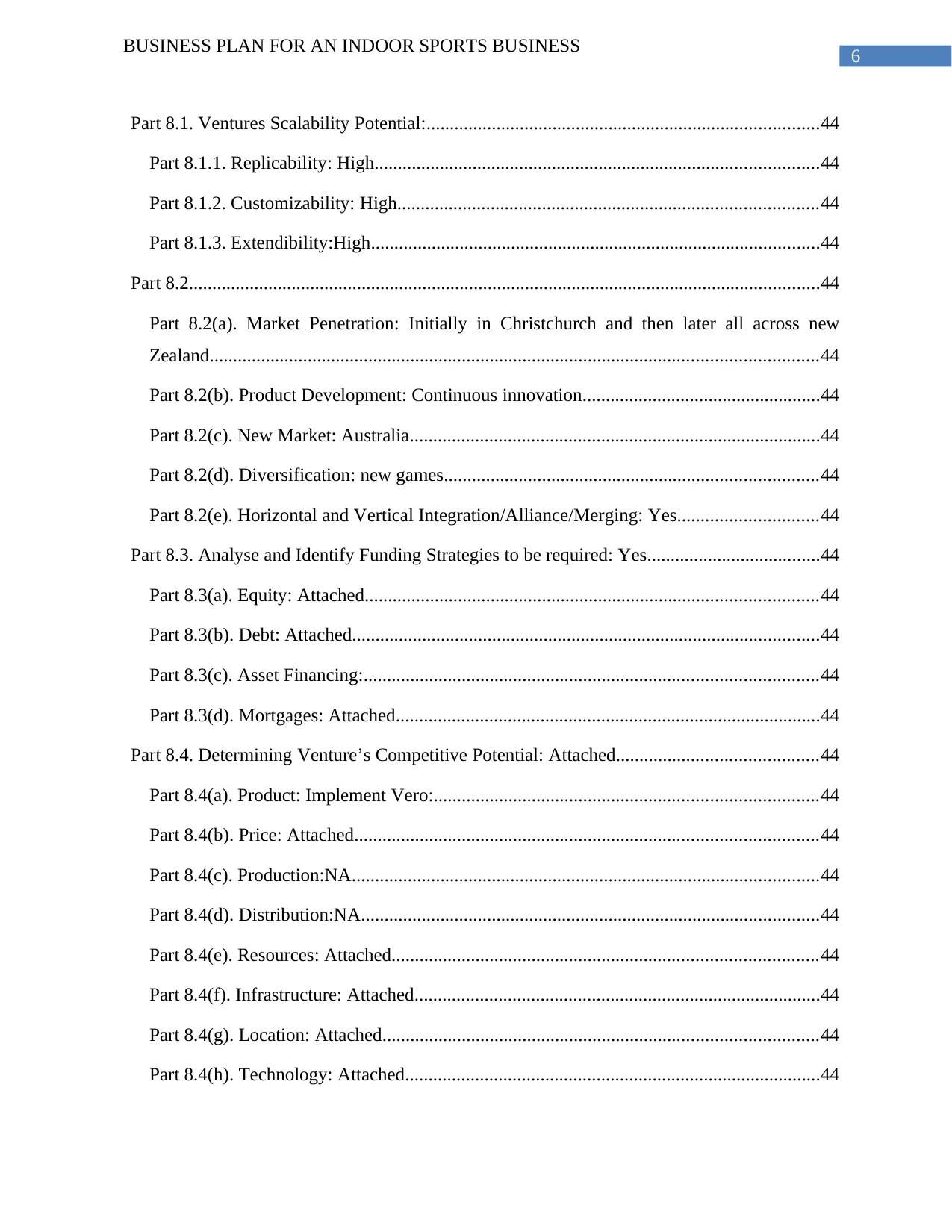
6
BUSINESS PLAN FOR AN INDOOR SPORTS BUSINESS
Part 8.1. Ventures Scalability Potential:....................................................................................44
Part 8.1.1. Replicability: High...............................................................................................44
Part 8.1.2. Customizability: High..........................................................................................44
Part 8.1.3. Extendibility:High................................................................................................44
Part 8.2.......................................................................................................................................44
Part 8.2(a). Market Penetration: Initially in Christchurch and then later all across new
Zealand..................................................................................................................................44
Part 8.2(b). Product Development: Continuous innovation...................................................44
Part 8.2(c). New Market: Australia........................................................................................44
Part 8.2(d). Diversification: new games................................................................................44
Part 8.2(e). Horizontal and Vertical Integration/Alliance/Merging: Yes..............................44
Part 8.3. Analyse and Identify Funding Strategies to be required: Yes.....................................44
Part 8.3(a). Equity: Attached.................................................................................................44
Part 8.3(b). Debt: Attached....................................................................................................44
Part 8.3(c). Asset Financing:.................................................................................................44
Part 8.3(d). Mortgages: Attached...........................................................................................44
Part 8.4. Determining Venture’s Competitive Potential: Attached...........................................44
Part 8.4(a). Product: Implement Vero:..................................................................................44
Part 8.4(b). Price: Attached...................................................................................................44
Part 8.4(c). Production:NA....................................................................................................44
Part 8.4(d). Distribution:NA..................................................................................................44
Part 8.4(e). Resources: Attached...........................................................................................44
Part 8.4(f). Infrastructure: Attached.......................................................................................44
Part 8.4(g). Location: Attached.............................................................................................44
Part 8.4(h). Technology: Attached.........................................................................................44
BUSINESS PLAN FOR AN INDOOR SPORTS BUSINESS
Part 8.1. Ventures Scalability Potential:....................................................................................44
Part 8.1.1. Replicability: High...............................................................................................44
Part 8.1.2. Customizability: High..........................................................................................44
Part 8.1.3. Extendibility:High................................................................................................44
Part 8.2.......................................................................................................................................44
Part 8.2(a). Market Penetration: Initially in Christchurch and then later all across new
Zealand..................................................................................................................................44
Part 8.2(b). Product Development: Continuous innovation...................................................44
Part 8.2(c). New Market: Australia........................................................................................44
Part 8.2(d). Diversification: new games................................................................................44
Part 8.2(e). Horizontal and Vertical Integration/Alliance/Merging: Yes..............................44
Part 8.3. Analyse and Identify Funding Strategies to be required: Yes.....................................44
Part 8.3(a). Equity: Attached.................................................................................................44
Part 8.3(b). Debt: Attached....................................................................................................44
Part 8.3(c). Asset Financing:.................................................................................................44
Part 8.3(d). Mortgages: Attached...........................................................................................44
Part 8.4. Determining Venture’s Competitive Potential: Attached...........................................44
Part 8.4(a). Product: Implement Vero:..................................................................................44
Part 8.4(b). Price: Attached...................................................................................................44
Part 8.4(c). Production:NA....................................................................................................44
Part 8.4(d). Distribution:NA..................................................................................................44
Part 8.4(e). Resources: Attached...........................................................................................44
Part 8.4(f). Infrastructure: Attached.......................................................................................44
Part 8.4(g). Location: Attached.............................................................................................44
Part 8.4(h). Technology: Attached.........................................................................................44
Paraphrase This Document
Need a fresh take? Get an instant paraphrase of this document with our AI Paraphraser
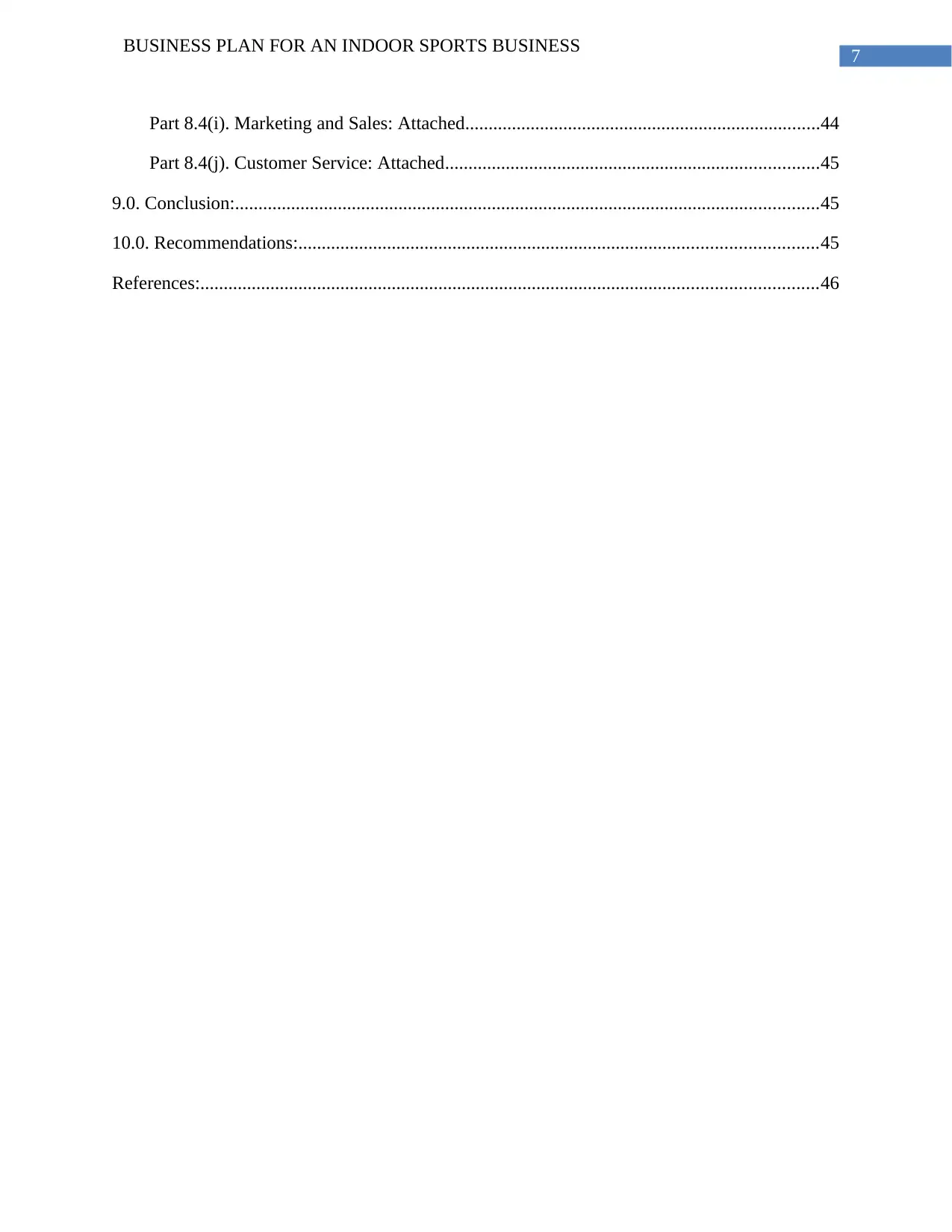
7
BUSINESS PLAN FOR AN INDOOR SPORTS BUSINESS
Part 8.4(i). Marketing and Sales: Attached............................................................................44
Part 8.4(j). Customer Service: Attached................................................................................45
9.0. Conclusion:.............................................................................................................................45
10.0. Recommendations:...............................................................................................................45
References:....................................................................................................................................46
BUSINESS PLAN FOR AN INDOOR SPORTS BUSINESS
Part 8.4(i). Marketing and Sales: Attached............................................................................44
Part 8.4(j). Customer Service: Attached................................................................................45
9.0. Conclusion:.............................................................................................................................45
10.0. Recommendations:...............................................................................................................45
References:....................................................................................................................................46
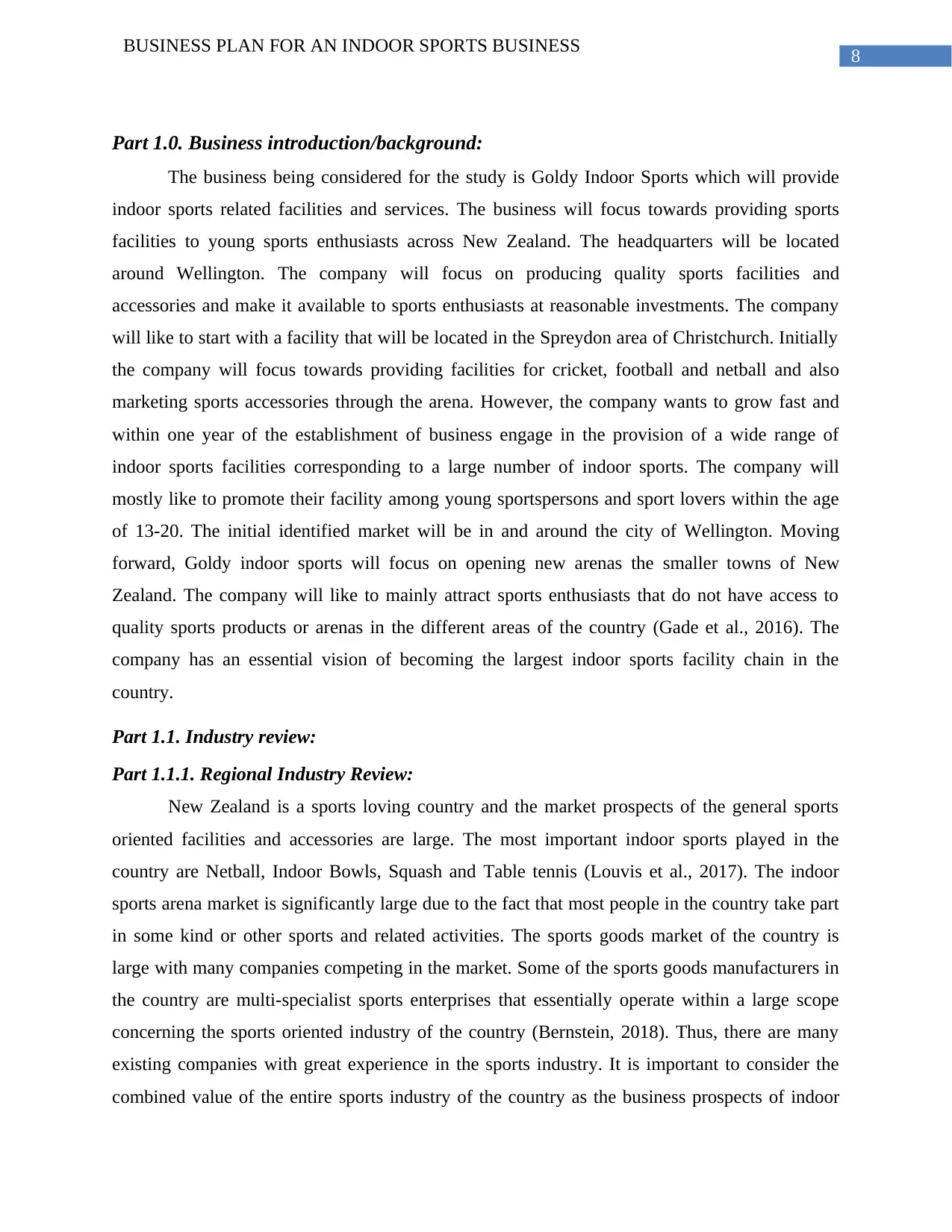
8
BUSINESS PLAN FOR AN INDOOR SPORTS BUSINESS
Part 1.0. Business introduction/background:
The business being considered for the study is Goldy Indoor Sports which will provide
indoor sports related facilities and services. The business will focus towards providing sports
facilities to young sports enthusiasts across New Zealand. The headquarters will be located
around Wellington. The company will focus on producing quality sports facilities and
accessories and make it available to sports enthusiasts at reasonable investments. The company
will like to start with a facility that will be located in the Spreydon area of Christchurch. Initially
the company will focus towards providing facilities for cricket, football and netball and also
marketing sports accessories through the arena. However, the company wants to grow fast and
within one year of the establishment of business engage in the provision of a wide range of
indoor sports facilities corresponding to a large number of indoor sports. The company will
mostly like to promote their facility among young sportspersons and sport lovers within the age
of 13-20. The initial identified market will be in and around the city of Wellington. Moving
forward, Goldy indoor sports will focus on opening new arenas the smaller towns of New
Zealand. The company will like to mainly attract sports enthusiasts that do not have access to
quality sports products or arenas in the different areas of the country (Gade et al., 2016). The
company has an essential vision of becoming the largest indoor sports facility chain in the
country.
Part 1.1. Industry review:
Part 1.1.1. Regional Industry Review:
New Zealand is a sports loving country and the market prospects of the general sports
oriented facilities and accessories are large. The most important indoor sports played in the
country are Netball, Indoor Bowls, Squash and Table tennis (Louvis et al., 2017). The indoor
sports arena market is significantly large due to the fact that most people in the country take part
in some kind or other sports and related activities. The sports goods market of the country is
large with many companies competing in the market. Some of the sports goods manufacturers in
the country are multi-specialist sports enterprises that essentially operate within a large scope
concerning the sports oriented industry of the country (Bernstein, 2018). Thus, there are many
existing companies with great experience in the sports industry. It is important to consider the
combined value of the entire sports industry of the country as the business prospects of indoor
BUSINESS PLAN FOR AN INDOOR SPORTS BUSINESS
Part 1.0. Business introduction/background:
The business being considered for the study is Goldy Indoor Sports which will provide
indoor sports related facilities and services. The business will focus towards providing sports
facilities to young sports enthusiasts across New Zealand. The headquarters will be located
around Wellington. The company will focus on producing quality sports facilities and
accessories and make it available to sports enthusiasts at reasonable investments. The company
will like to start with a facility that will be located in the Spreydon area of Christchurch. Initially
the company will focus towards providing facilities for cricket, football and netball and also
marketing sports accessories through the arena. However, the company wants to grow fast and
within one year of the establishment of business engage in the provision of a wide range of
indoor sports facilities corresponding to a large number of indoor sports. The company will
mostly like to promote their facility among young sportspersons and sport lovers within the age
of 13-20. The initial identified market will be in and around the city of Wellington. Moving
forward, Goldy indoor sports will focus on opening new arenas the smaller towns of New
Zealand. The company will like to mainly attract sports enthusiasts that do not have access to
quality sports products or arenas in the different areas of the country (Gade et al., 2016). The
company has an essential vision of becoming the largest indoor sports facility chain in the
country.
Part 1.1. Industry review:
Part 1.1.1. Regional Industry Review:
New Zealand is a sports loving country and the market prospects of the general sports
oriented facilities and accessories are large. The most important indoor sports played in the
country are Netball, Indoor Bowls, Squash and Table tennis (Louvis et al., 2017). The indoor
sports arena market is significantly large due to the fact that most people in the country take part
in some kind or other sports and related activities. The sports goods market of the country is
large with many companies competing in the market. Some of the sports goods manufacturers in
the country are multi-specialist sports enterprises that essentially operate within a large scope
concerning the sports oriented industry of the country (Bernstein, 2018). Thus, there are many
existing companies with great experience in the sports industry. It is important to consider the
combined value of the entire sports industry of the country as the business prospects of indoor
⊘ This is a preview!⊘
Do you want full access?
Subscribe today to unlock all pages.

Trusted by 1+ million students worldwide
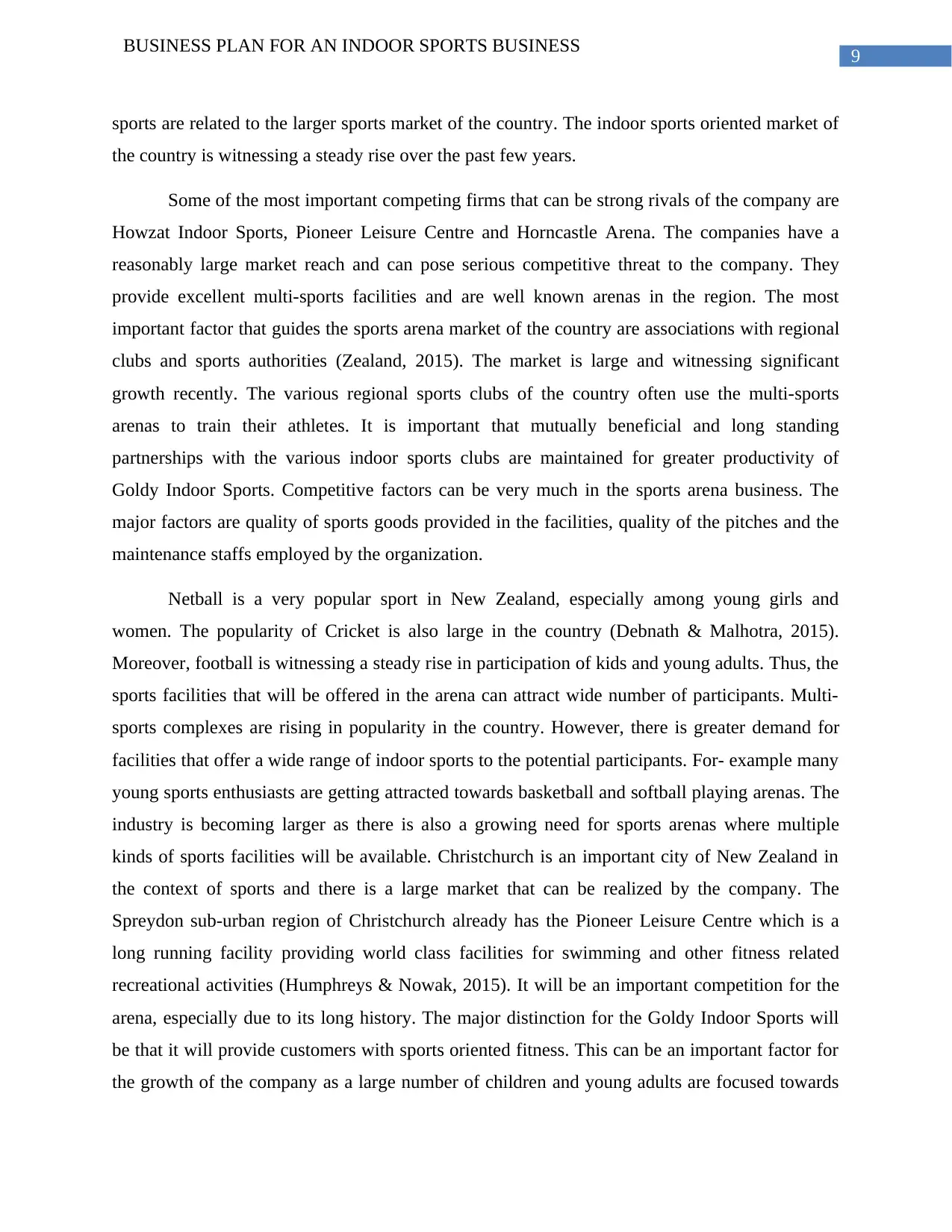
9
BUSINESS PLAN FOR AN INDOOR SPORTS BUSINESS
sports are related to the larger sports market of the country. The indoor sports oriented market of
the country is witnessing a steady rise over the past few years.
Some of the most important competing firms that can be strong rivals of the company are
Howzat Indoor Sports, Pioneer Leisure Centre and Horncastle Arena. The companies have a
reasonably large market reach and can pose serious competitive threat to the company. They
provide excellent multi-sports facilities and are well known arenas in the region. The most
important factor that guides the sports arena market of the country are associations with regional
clubs and sports authorities (Zealand, 2015). The market is large and witnessing significant
growth recently. The various regional sports clubs of the country often use the multi-sports
arenas to train their athletes. It is important that mutually beneficial and long standing
partnerships with the various indoor sports clubs are maintained for greater productivity of
Goldy Indoor Sports. Competitive factors can be very much in the sports arena business. The
major factors are quality of sports goods provided in the facilities, quality of the pitches and the
maintenance staffs employed by the organization.
Netball is a very popular sport in New Zealand, especially among young girls and
women. The popularity of Cricket is also large in the country (Debnath & Malhotra, 2015).
Moreover, football is witnessing a steady rise in participation of kids and young adults. Thus, the
sports facilities that will be offered in the arena can attract wide number of participants. Multi-
sports complexes are rising in popularity in the country. However, there is greater demand for
facilities that offer a wide range of indoor sports to the potential participants. For- example many
young sports enthusiasts are getting attracted towards basketball and softball playing arenas. The
industry is becoming larger as there is also a growing need for sports arenas where multiple
kinds of sports facilities will be available. Christchurch is an important city of New Zealand in
the context of sports and there is a large market that can be realized by the company. The
Spreydon sub-urban region of Christchurch already has the Pioneer Leisure Centre which is a
long running facility providing world class facilities for swimming and other fitness related
recreational activities (Humphreys & Nowak, 2015). It will be an important competition for the
arena, especially due to its long history. The major distinction for the Goldy Indoor Sports will
be that it will provide customers with sports oriented fitness. This can be an important factor for
the growth of the company as a large number of children and young adults are focused towards
BUSINESS PLAN FOR AN INDOOR SPORTS BUSINESS
sports are related to the larger sports market of the country. The indoor sports oriented market of
the country is witnessing a steady rise over the past few years.
Some of the most important competing firms that can be strong rivals of the company are
Howzat Indoor Sports, Pioneer Leisure Centre and Horncastle Arena. The companies have a
reasonably large market reach and can pose serious competitive threat to the company. They
provide excellent multi-sports facilities and are well known arenas in the region. The most
important factor that guides the sports arena market of the country are associations with regional
clubs and sports authorities (Zealand, 2015). The market is large and witnessing significant
growth recently. The various regional sports clubs of the country often use the multi-sports
arenas to train their athletes. It is important that mutually beneficial and long standing
partnerships with the various indoor sports clubs are maintained for greater productivity of
Goldy Indoor Sports. Competitive factors can be very much in the sports arena business. The
major factors are quality of sports goods provided in the facilities, quality of the pitches and the
maintenance staffs employed by the organization.
Netball is a very popular sport in New Zealand, especially among young girls and
women. The popularity of Cricket is also large in the country (Debnath & Malhotra, 2015).
Moreover, football is witnessing a steady rise in participation of kids and young adults. Thus, the
sports facilities that will be offered in the arena can attract wide number of participants. Multi-
sports complexes are rising in popularity in the country. However, there is greater demand for
facilities that offer a wide range of indoor sports to the potential participants. For- example many
young sports enthusiasts are getting attracted towards basketball and softball playing arenas. The
industry is becoming larger as there is also a growing need for sports arenas where multiple
kinds of sports facilities will be available. Christchurch is an important city of New Zealand in
the context of sports and there is a large market that can be realized by the company. The
Spreydon sub-urban region of Christchurch already has the Pioneer Leisure Centre which is a
long running facility providing world class facilities for swimming and other fitness related
recreational activities (Humphreys & Nowak, 2015). It will be an important competition for the
arena, especially due to its long history. The major distinction for the Goldy Indoor Sports will
be that it will provide customers with sports oriented fitness. This can be an important factor for
the growth of the company as a large number of children and young adults are focused towards
Paraphrase This Document
Need a fresh take? Get an instant paraphrase of this document with our AI Paraphraser

10
BUSINESS PLAN FOR AN INDOOR SPORTS BUSINESS
indoor sports. There is also a growing concern of childhood obesity in the country which is
prompting many parents to send their children to various sports arenas and associate them with
various sports activities (Zealand, 2015). It is important for the company to engage in effective
marketing activities that will target young sports enthusiasts.
Large sports arenas are being built across the country for integrating budding sports
enthusiasts under one roof. The growth of multi-sport arenas across the country are also being
promoted by the sports ministry in order to educate children and teenagers about new sports.
Moreover, there is also a growing trend among teenagers and young adults towards becoming
multi-disciplinary athletes. The Arena can specifically address this need among the sports
enthusiastic children in Christchurch. Providing a good environment and atmosphere is also
necessary as multi-sports arenas across the country and the city are focusing more towards
enhancing the ambience of their arenas (Leeds et al., 2018). The government authorities of
Christchurch are also providing increased facilities to sport venues and arenas in a bid to
improve sports participation rates among the children and youth of the region. Moreover, the
authorities are trying to improve public health through the promotion of healthier lifestyles. This
is important for the growth and development for the Arena. The Pioneer Leisure center is
concentrated more towards providing swimming facilities to the people of the region. However,
as a sports oriented arena the prospects of the company are good.
Part 1.1.2. Global Industry Review:
Sports arenas have been long existing in the global sports oriented market. The growth of
major multi-sports facilities happened during the 1970s and 80s (Holmgren & Widmark, 2018).
The global sports market was recently recorded to generate revenue figures of more than 90
Billion worth of US dollars. The market is growing along with the rise in sports viewership
across the globe. It is important for the company to consider the rise of the global sports industry
as sports affinity mostly develops due to major events and occurrences that take place globally.
The rise in the global sports market was witnessed in the last few years majorly due to the
hosting of various large sporting events by emerging world economies. The rapid growth of
viewership in regards to various sports were witnessed across the globe. Events like the Summer
Olympics and the FIFA World Cup further boost prospects of the sports industry across the
world. The growing popularity of Rugby in the Southern hemisphere has resulted in the
BUSINESS PLAN FOR AN INDOOR SPORTS BUSINESS
indoor sports. There is also a growing concern of childhood obesity in the country which is
prompting many parents to send their children to various sports arenas and associate them with
various sports activities (Zealand, 2015). It is important for the company to engage in effective
marketing activities that will target young sports enthusiasts.
Large sports arenas are being built across the country for integrating budding sports
enthusiasts under one roof. The growth of multi-sport arenas across the country are also being
promoted by the sports ministry in order to educate children and teenagers about new sports.
Moreover, there is also a growing trend among teenagers and young adults towards becoming
multi-disciplinary athletes. The Arena can specifically address this need among the sports
enthusiastic children in Christchurch. Providing a good environment and atmosphere is also
necessary as multi-sports arenas across the country and the city are focusing more towards
enhancing the ambience of their arenas (Leeds et al., 2018). The government authorities of
Christchurch are also providing increased facilities to sport venues and arenas in a bid to
improve sports participation rates among the children and youth of the region. Moreover, the
authorities are trying to improve public health through the promotion of healthier lifestyles. This
is important for the growth and development for the Arena. The Pioneer Leisure center is
concentrated more towards providing swimming facilities to the people of the region. However,
as a sports oriented arena the prospects of the company are good.
Part 1.1.2. Global Industry Review:
Sports arenas have been long existing in the global sports oriented market. The growth of
major multi-sports facilities happened during the 1970s and 80s (Holmgren & Widmark, 2018).
The global sports market was recently recorded to generate revenue figures of more than 90
Billion worth of US dollars. The market is growing along with the rise in sports viewership
across the globe. It is important for the company to consider the rise of the global sports industry
as sports affinity mostly develops due to major events and occurrences that take place globally.
The rise in the global sports market was witnessed in the last few years majorly due to the
hosting of various large sporting events by emerging world economies. The rapid growth of
viewership in regards to various sports were witnessed across the globe. Events like the Summer
Olympics and the FIFA World Cup further boost prospects of the sports industry across the
world. The growing popularity of Rugby in the Southern hemisphere has resulted in the
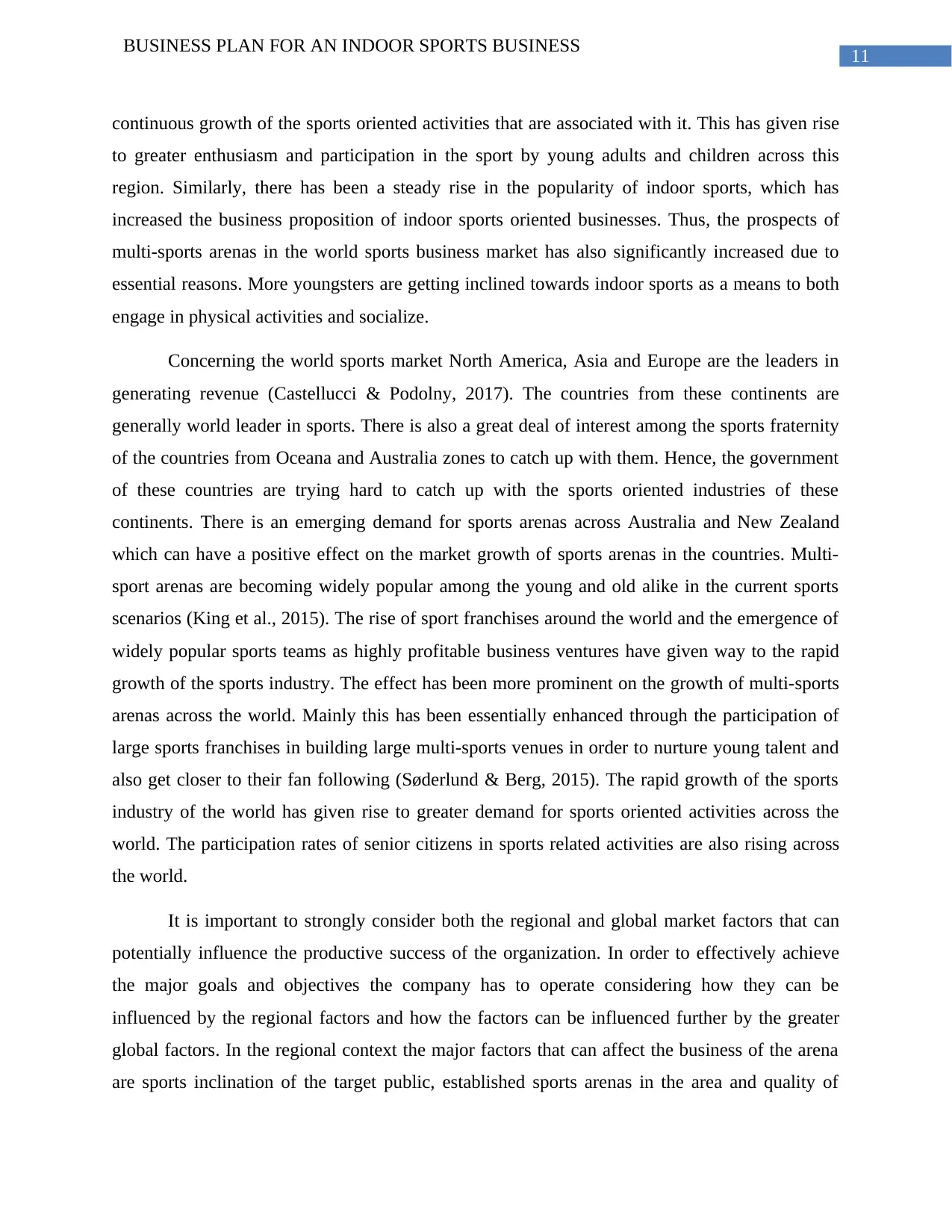
11
BUSINESS PLAN FOR AN INDOOR SPORTS BUSINESS
continuous growth of the sports oriented activities that are associated with it. This has given rise
to greater enthusiasm and participation in the sport by young adults and children across this
region. Similarly, there has been a steady rise in the popularity of indoor sports, which has
increased the business proposition of indoor sports oriented businesses. Thus, the prospects of
multi-sports arenas in the world sports business market has also significantly increased due to
essential reasons. More youngsters are getting inclined towards indoor sports as a means to both
engage in physical activities and socialize.
Concerning the world sports market North America, Asia and Europe are the leaders in
generating revenue (Castellucci & Podolny, 2017). The countries from these continents are
generally world leader in sports. There is also a great deal of interest among the sports fraternity
of the countries from Oceana and Australia zones to catch up with them. Hence, the government
of these countries are trying hard to catch up with the sports oriented industries of these
continents. There is an emerging demand for sports arenas across Australia and New Zealand
which can have a positive effect on the market growth of sports arenas in the countries. Multi-
sport arenas are becoming widely popular among the young and old alike in the current sports
scenarios (King et al., 2015). The rise of sport franchises around the world and the emergence of
widely popular sports teams as highly profitable business ventures have given way to the rapid
growth of the sports industry. The effect has been more prominent on the growth of multi-sports
arenas across the world. Mainly this has been essentially enhanced through the participation of
large sports franchises in building large multi-sports venues in order to nurture young talent and
also get closer to their fan following (Søderlund & Berg, 2015). The rapid growth of the sports
industry of the world has given rise to greater demand for sports oriented activities across the
world. The participation rates of senior citizens in sports related activities are also rising across
the world.
It is important to strongly consider both the regional and global market factors that can
potentially influence the productive success of the organization. In order to effectively achieve
the major goals and objectives the company has to operate considering how they can be
influenced by the regional factors and how the factors can be influenced further by the greater
global factors. In the regional context the major factors that can affect the business of the arena
are sports inclination of the target public, established sports arenas in the area and quality of
BUSINESS PLAN FOR AN INDOOR SPORTS BUSINESS
continuous growth of the sports oriented activities that are associated with it. This has given rise
to greater enthusiasm and participation in the sport by young adults and children across this
region. Similarly, there has been a steady rise in the popularity of indoor sports, which has
increased the business proposition of indoor sports oriented businesses. Thus, the prospects of
multi-sports arenas in the world sports business market has also significantly increased due to
essential reasons. More youngsters are getting inclined towards indoor sports as a means to both
engage in physical activities and socialize.
Concerning the world sports market North America, Asia and Europe are the leaders in
generating revenue (Castellucci & Podolny, 2017). The countries from these continents are
generally world leader in sports. There is also a great deal of interest among the sports fraternity
of the countries from Oceana and Australia zones to catch up with them. Hence, the government
of these countries are trying hard to catch up with the sports oriented industries of these
continents. There is an emerging demand for sports arenas across Australia and New Zealand
which can have a positive effect on the market growth of sports arenas in the countries. Multi-
sport arenas are becoming widely popular among the young and old alike in the current sports
scenarios (King et al., 2015). The rise of sport franchises around the world and the emergence of
widely popular sports teams as highly profitable business ventures have given way to the rapid
growth of the sports industry. The effect has been more prominent on the growth of multi-sports
arenas across the world. Mainly this has been essentially enhanced through the participation of
large sports franchises in building large multi-sports venues in order to nurture young talent and
also get closer to their fan following (Søderlund & Berg, 2015). The rapid growth of the sports
industry of the world has given rise to greater demand for sports oriented activities across the
world. The participation rates of senior citizens in sports related activities are also rising across
the world.
It is important to strongly consider both the regional and global market factors that can
potentially influence the productive success of the organization. In order to effectively achieve
the major goals and objectives the company has to operate considering how they can be
influenced by the regional factors and how the factors can be influenced further by the greater
global factors. In the regional context the major factors that can affect the business of the arena
are sports inclination of the target public, established sports arenas in the area and quality of
⊘ This is a preview!⊘
Do you want full access?
Subscribe today to unlock all pages.

Trusted by 1+ million students worldwide
1 out of 55
Related Documents
Your All-in-One AI-Powered Toolkit for Academic Success.
+13062052269
info@desklib.com
Available 24*7 on WhatsApp / Email
![[object Object]](/_next/static/media/star-bottom.7253800d.svg)
Unlock your academic potential
Copyright © 2020–2025 A2Z Services. All Rights Reserved. Developed and managed by ZUCOL.





